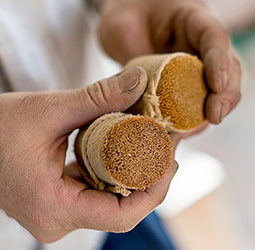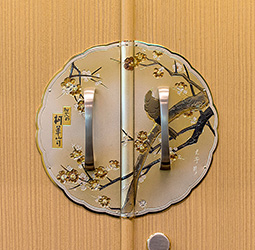Home > Highlighting JAPAN > Highlighting Japan April 2017 > Traditional Crafts
Highlighting JAPAN


Lords of the Tansu
Rob Gilhooly visits a kiri-tansu chest maker in Kamo, Niigata Prefecture.
A length of light-colored wood firmly gripped in his left hand, Tsutomu Ohashi deftly cuts away at a joint using a chisel-like implement that he says holds an important key to his trade. Unlike a chisel, the tool, which is known as a “nomi,” should be moved laterally rather than longitudinally to avoid removing too much wood or creating disastrous splits. “To ensure the grain of the wood looks its absolute best, the nomi must be very sharp, and we artisans have to use them with extreme care and skill,” Ohashi says.
Ohashi has spent thirty-three years applying that modus operandi to the building of what is arguably Japan’s most quintessential item of furniture, the kiri-tansu, a wardrobe-cum-chest of drawers that is made from kiri, or paulownia, a wood that is second only to balsa in terms of its weight.
Ohashi works at Asakura Kagu, one of a twenty-four-member Kamo tansu cooperative making a well-known variety of the wardrobes in Kamo, Niigata Prefecture. Kiri-tansu have been produced in this region of northeastern Japan for over 220 years, assisted by a favorable climate and a healthy supply of kiri, a wood which is seldom used for furniture-making outside Japan owing to its “borderline strength,” according to Katsuji Shigeno, president of the cooperative.
“The roots to kiri-tansu development in Japan was a great fire in 1657 known as the ‘meireki no taika,’ which is said to have killed more than 100,000 people,” Shigeno explains.
“The reason for the hefty death toll was that roadways had become blocked by ‘kuruma-tansu,’ heavy, cumbersome chests that were being wheeled along by people trying to escape the flames.”
Subsequently, an abolition order was issued against kuruma-tansu by the Edo shogunate and a search began to find a lighter wood for the chests, Shigeno adds.
“In the past Kamo had many paulownia trees, and makers would cut these down and make kiri-tansu entirely by hand,” Yasunori Asakura, president of Asakura Kagu. “This total-integration process, from the sourcing and milling of the wood to the crafting of the product remains a characteristic that is unique to Kamo.”
While machinery has taken over some parts of the production process, the majority is still undertaken by hand.
Sourced wood is first left outside for one to three years where it is exposed to the elements to remove tannins, which not only ensures the wood is less susceptible to warping and rot, but also prevents discoloration.
After the surface is planed, the wood sheets are cut into relatively narrow lengths and then carefully aligned for laminating.
According to production chief Atsushi Asakura, this is the most crucial stage in the production process, with the success or failure of matching the grain of each sheet being crucial in determining whether the end product “lives or dies.”
Assembly of the body and drawers requires an equal degree of skill, not least because not one metal screw or nail is employed throughout the process. Once assembled, the surface is coated with stainer made from various colored tonoko (powdered clay), after which the metal fittings, such as ornate handles and brackets, are attached.
“Different colored stainer is applied according to the region we are supplying,” explains artisan Hiromitsu Tanaka, as he applies an unusually shaped brush to the wood to bring out the grain.
Today, Asakura Kagu’s six artisans produce around 150 sets of the wardrobes per year, a far cry from the 1950s hey-day when more than thirty craftsmen assembled up to 800 kiri-tansu annually, says president Asakura. Indeed, during that peak, there were more than 200 makers in the area, he adds.
With the gradual change in living conditions since World War II, not to mention an influx of cheaper, machine-manufactured furniture, demand for kiri-tansu has declined, though in recent years interest from overseas has given Kamo’s makers hope of a new kiri-tansu golden era.
“It seems there is an appreciation abroad of things that are quintessentially Japanese, which has stiffened our resolve to continue making Kamo kiri-tansu in the time-honored tradition.”
© 2009 Cabinet Office, Government of Japan










